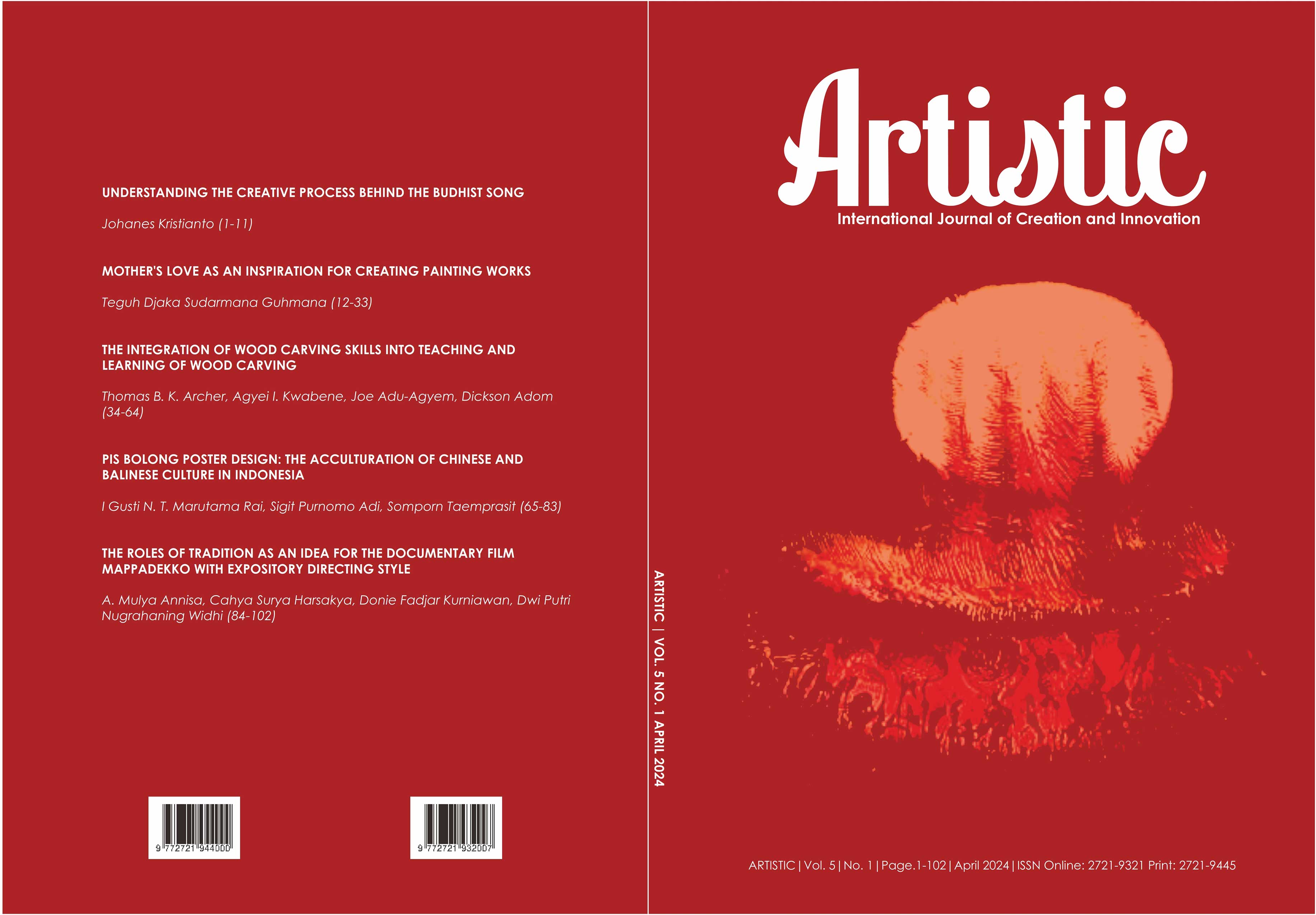PIS BOLONG POSTER DESIGN: THE ACCULTURATION OF CHINESE AND BALINESE CULTURE IN INDONESIA
DOI:
https://doi.org/10.33153/artistic.v5i1.6324Keywords:
Poster Design, Acculturation, Chinese and Balinese Culture.Abstract
This study explores the integration of Chinese and Balinese cultural elements in poster design as a means of visual communication. This study aims to understand how cultural acculturation is manifested in poster design by integrating visual idioms from both cultures to convey messages of solidarity, tolerance, and cultural appreciation and preservation. Using qualitative research and a Design Thinking approach, this study seeks to present cultural acculturation values in poster design elements and evaluate their impact on the audience. The research findings demonstrate that the combination of Chinese and Balinese cultural symbols, colors, and patterns effectively produced a communicative and aesthetically appealing visual narrative. These findings highlight the significance of cultural comprehension in visual communication design and contribute to the development of culture-based design practices. This study enhances our understanding of the function of design in communicating cultural values.
Downloads
References
Alit, D. M.. (2024). Jejak Cina pada Sistem Keyakinan Masyarakat Bali : Dari Persepektif Sejarah. Nirwasita: Jurnal Pendidikan Sejarah dan Ilmu Sosial 5 (1): 14–26. https://doi.org/DOI:10.59672/nirwasita.v5i1.3617.
Andhisti, K.. (2022). The Transformation of Majapahit Temple Ornaments into Batik Motifs. ARTISTIC: International Journal of Creation and Innovation 3(2): 177–91. https://doi.org/https://doi.org/10.33153/artistic.v3i2.4524.
Arikunto, S. (2013). Prosedur Penelitian: Suatu Pendekatan Praktik. Ed.rev 04,. Rineka Cipta.
Aryaputri, N. T. R., Arimbawa, I M. G., Ruspawati, I. A. W. (2020). Akulturasi dan Nilai-Nilai Estetika dalam Busana Payas Agung Ningrat Buleleng di Puri Kanginan Singaraja. Prabangkara: Jurnal Seni Rupa dan Desain 24(1): 24–34.
Ayuna, N. E. (2023). “Peran Komunikasi Dalam Proses Akulturasi Sistem Sosial Lokal.” Technomedia Journal 8 (1): 35–51. https://doi.org/https://doi.org/10.33050/tmj.v8i1.2015.
Beratha, N L S., Ruspawati, I W. A., Dhana, I N. (2011). Hubungan Komunitas Cina dan Bali Perspektif Multikulturalisme. Mudra Jurnal Seni Budaya 26(1): 36–40. https://doi.org/DOI:10.31091/mudra.v26i1.1587.
Berry, J. W. (2005). Acculturation: Living Successfully in Two Cultures. International Journal of Intercultural Relations 29(6): 697–712. https://doi.org/https://doi.org/10.1016/j.ijintrel.2005.07.013.
Brown, T. (2009). Change by Design: How Design Thinking Thinking Transforms Organizations and Inspires Innovation. I. Harper Collins.
Cross, N. (2023). Design Thinking: Understanding How Designers Think and Work. II. London. New York. New Delhi. Sydney: Bloomsbury Publishing. Retrieved from https://dokumen.pub/design-thinking-understanding-how-designers-think-and-work-2nbsped-1350305022-9781350305021.html.
Croucher, S. M. & Kramer, E. (2017). Cultural Fusion Theory: An Alternative to Acculturation. Journal of International and Intercultural Communication 10(2): 97–114. https://doi.org/DOI: 10.1080/17513057.2016.1229498.
Hadi, A., Asrori, Rusman. (2021). Penelitian Kualitatif: Studi Fenomenologi, Case Study, Grounded Theory, Etnografi, Biografi. I. CV. Pena Persada.
Halskov, K. & Christensen, B. T. (2018). Designing across Cultures. CoDesign 14(2): 75–78. https://doi.org/10.1080/15710882.2018.1459101.
Hauser-Schäublin, B. (2014). 3 from Subandar to Tridharma: Transformations and Interactions of Chinese Communities in Bali. In Between Harmony and Discrimination Negotiating Religious Identities within Majority-Minority Relationships in Bali and Lombok, Brill. https://doi.org/https://doi.org/10.1163/9789004271494_005.
Kodiran. (1998). Akulturasi sebagai Mekanisme Perubahan Kebudayaan. Humaniora 10(8): 87–91. https://doi.org/10.22146/JH.2064.
Koentjaraningrat. (2005). Pengantar Antropologi. Rineka Cipta.
Kristanti & Guntur. (2021). Kyai Rajamala Boat Canthik in Couture Batik Pattern. ARTISTIC: International Journal of Creation and Innovation 2(2): 120–32, https://doi.org/10.33153/artistic.v2i2.4047.
Marutama, I G. N. T. & Adi, S. P. (2023). Perancangan Ilustrasi Canthik Rajamala pada Kaos sebagai Media Komunikasi Identitas Budaya Kota Surakarta. In SNADES: Masa Depan Desain di Era Digital Untuk Indonesia, 292–305. Fak. Arsitektur dan Desain UPN Jatim.
Moleong, L. J. (2019). Metodologi Penelitian Kualitatif. Edisi Revi. Remaja Rosdakarya.
Muasmara, R. & Ajmain, Nahrim. (2020). Akulturasi Islam dan Budaya Nusantara.” Tanjak: Journal of Education and Teaching 1(2): 111–25. https://doi.org/DOI: https://doi.org/10.35961/tanjak.v1i2.150.
Pryshchenko, S. V. (2021). Cultural Heritage of a Poster: Communicative and Creative Experience. Creativity Studies 14(1): 18–33. https://doi.org/https://doi.org/10.3846/cs.2021.12605.
Raka, A. A. G., Mardika, I M., Wahyuni, N., Warmadewi, A. A. I. M. (2020). Chinese Ancient Coin - Uang Kepeng: A Strengthener of Bali and China Relationship. Journal of Environmental Management and Tourism 11(2): 271–80. https://doi.org/DOI:10.14505//jemt.v11.2(42).05.
Sari, N. M. A. E. T. R. (2020). Barong Landung: Akulturasi Budaya Bali dan Tionghoa. Jurnal Penelitian Sejarah dan Budaya 6(2): 270–96. https://doi.org/10.36424/jpsb.v6i2.199.
Tinarbuko, S. (2015). DEKAVE: Desain Konunikasi Visual Penanda Zaman Masyarakat Global. CAPS.
Weifen, Q. (2023). A Study of Traditional Chinese Elements in Balinese Culture: An Acculturation Perspective. Aristo: Socisl, Politik, Humaniora) 11(1): 71–97. https://doi.org/10.24269/ars.v11i1.5315.
Xu, Z. (2024). The Evolution of Cultural Symbols in Graphic Design. Frontiers in Art Research 6(4): 85–93. https://doi.org/DOI: 10.25236/FAR.2024.060415.
Downloads
Published
How to Cite
Issue
Section
License
Copyright (c) 2024 I Gusti Ngurah Tri Marutama Rai, Sigit Purnomo Adi, Somporn Taemprasit

This work is licensed under a Creative Commons Attribution-NonCommercial-ShareAlike 4.0 International License.
Copyright
Authors who publish with Artistic agree to the following terms:
- Authors retain copyright and grant the journal right of first publication with the work simultaneously licensed under a Creative Commons Attribution License (CC BY-SA 4.0) that allows others to share the work with an acknowledgment of the work's authorship and initial publication in this journal.
- Authors are able to enter into separate, additional contractual arrangements for the non-exclusive distribution of the journal's published version of the work (e.g., post it to an institutional repository or publish it in a book), with an acknowledgment of its initial publication in this journal.
This work is licensed under a Creative Commons Attribution-ShareAlike 4.0


